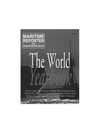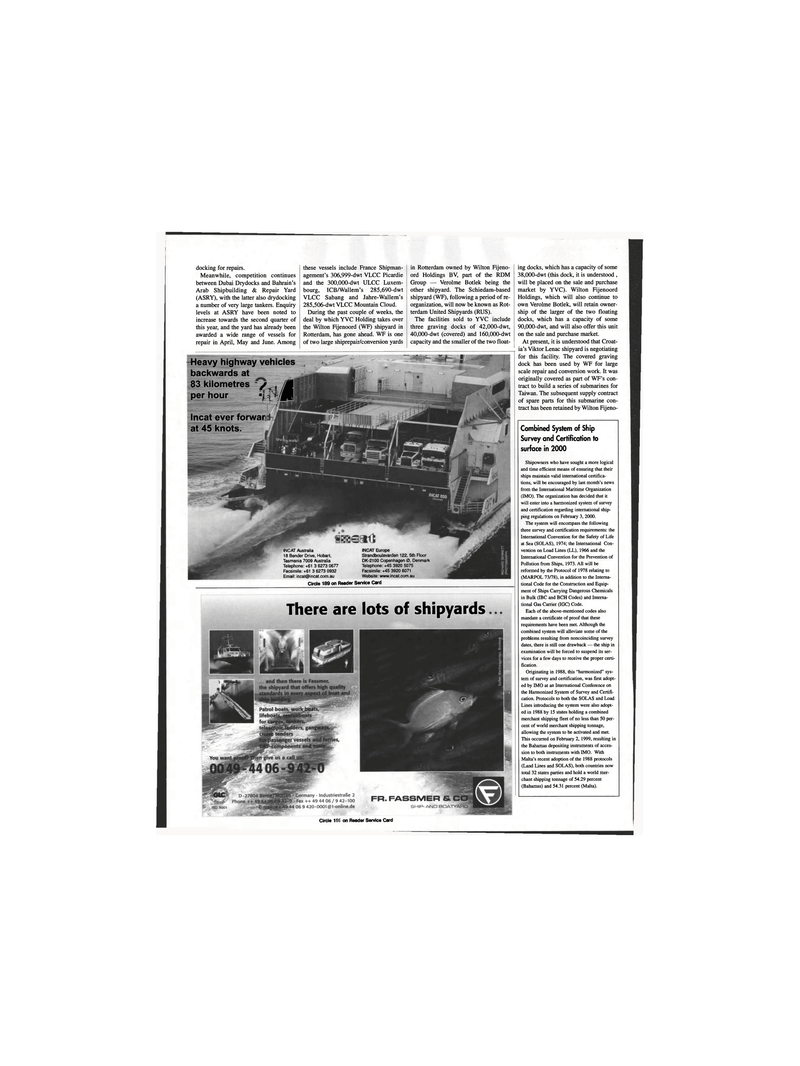
Page 110: of Maritime Reporter Magazine (June 1999)
Read this page in Pdf, Flash or Html5 edition of June 1999 Maritime Reporter Magazine
docking for repairs.
Meanwhile, competition continues between Dubai Drydocks and Bahrain's
Arab Shipbuilding & Repair Yard (ASRY), with the latter also drydocking a number of very large tankers. Enquiry levels at ASRY have been noted to increase towards the second quarter of this year, and the yard has already been awarded a wide range of vessels for repair in April, May and June. Among these vessels include France Shipman- agement's 306,999-dwt VLCC Picardie and the 300,000-dwt ULCC Luxem- bourg, ICBAVallem's 285,690-dwt
VLCC Sabang and Jahre-Wallem's 285,506-dwt VLCC Mountain Cloud.
During the past couple of weeks, the deal by which YVC Holding takes over the Wilton Fijenoord (WF) shipyard in
Rotterdam, has gone ahead. WF is one of two large shiprepair/conversion yards in Rotterdam owned by Wilton Fijeno- ord Holdings BV, part of the RDM
Group — Verolme Botlek being the other shipyard. The Schiedam-based shipyard (WF), following a period of re- organization, will now be known as Rot- terdam United Shipyards (RUS).
The facilities sold to YVC include three graving docks of 42,000-dwt, 40,000-dwt (covered) and 160,000-dwt capacity and the smaller of the two float- ing docks, which has a capacity of some 38,000-dwt (this dock, it is understood , will be placed on the sale and purchase market by YVC). Wilton Fijenoord
Holdings, which will also continue to own Verolme Botlek, will retain owner- ship of the larger of the two floating docks, which has a capacity of some 90,000-dwt, and will also offer this unit on the sale and purchase market.
At present, it is understood that Croat- ia's Viktor Lenac shipyard is negotiating for this facility. The covered graving dock has been used by WF for large scale repair and conversion work. It was originally covered as part of WF's con- tract to build a series of submarines for
Taiwan. The subsequent supply contract of spare parts for this submarine con- tract has been retained by Wilton Fijeno-
There are lots of shipyards
Combined System of Ship
Survey and Certification to surface in 2000
Shipowners who have sought a more logical and time efficient means of ensuring that their ships maintain valid international certifica- tions, will be encouraged by last month's news from the International Maritime Organization (IMO). The organization has decided that it will enter into a harmonized system of survey and certification regarding international ship- ping regulations on February 3, 2000.
The system will encompass the following three survey and certification requirements: the
International Convention for the Safety of Life at Sea (SOLAS), 1974; the International Con- vention on Load Lines (LL), 1966 and the
International Convention for the Prevention of
Pollution from Ships, 1973. All will be reformed by the Protocol of 1978 relating to (MARPOL 73/78), in addition to the Interna- tional Code for the Construction and Equip- ment of Ships Carrying Dangerous Chemicals in Bulk (IBC and BCH Codes) and Interna- tional Gas Carrier (IGC) Code.
Each of the above-mentioned codes also mandate a certificate of proof that these requirements have been met. Although the combined system will alleviate some of the problems resulting from noncoinciding survey dates, there is still one drawback — the ship in examination will be forced to suspend its ser- vices for a few days to receive the proper certi- fication.
Originating in 1988, this "harmonized" sys- tem of survey and certification, was first adopt- ed by IMO at an International Conference on the Harmonized System of Survey and Certifi- cation. Protocols to both the SOLAS and Load
Lines introducing the system were also adopt- ed in 1988 by 15 states holding a combined merchant shipping fleet of no less than 50 per- cent of world merchant shipping tonnage, allowing the system to be activated and met.
This occurred on February 2, 1999, resulting in the Bahamas depositing instruments of acces- sion to both instruments with IMO. With
Malta's recent adoption of the 1988 protocols (Land Lines and SOLAS), both countries now total 32 states parties and hold a world mer- chant shipping tonnage of 54.29 percent (Bahamas) and 54.31 percent (Malta). -Heavy highway vehicles backwards at 83 kilometres k Jj\ per hour " J1
Incat ever forwan at 45 knots.
INCAT Europe
Strandboulevarden 122, 5th Floor
DK-2100 Copenhagen 0, Denmark
Telephone: +45 3920 5075
Facsimile: +45 3920 6071
Website: www.incat.com.au
INCAT Australia 18 Bender Drive, Hobart,
Tasmania 7009 Australia
Telephone: +61 3 6273 0677
Facsimile: +61 3 6273 0932
Email: [email protected]
Circle 189 on Reader Service Card
Circle 281 on Reader Service Card

 109
109

 111
111
